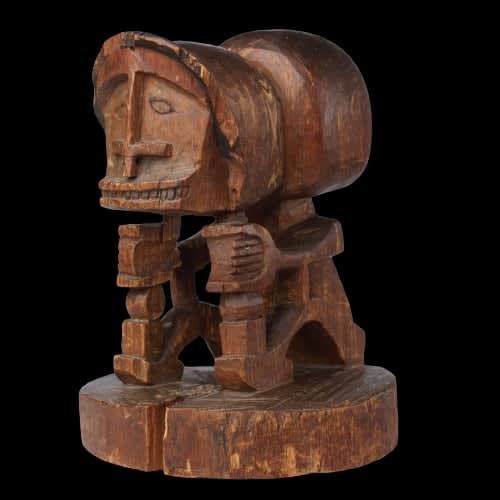An extremely rare Papua wood sculpture of a Korwar Papua New Guinea, Cendrawasih Bay, Wandammen, early 19th century
Finely
carved in the early style, the figure seated on a circular base, with an
elongated head, detailed facial expression with blackened eyebrows, lashes,
moustache and teeth, the ears and forehead pierced, all areas facing upwards
with a deep black-brown patina of usage and insect droppings. With a
hand-written label to the bottom stating Korwar Patoeng Nenek- Mojang Orang
Papua. Inscribed Biak Papua on the forehead and indistinctly inscribed in
French on the back of the head. This rare type of Korwar belongs to the
earliest pieces known to exist, as stated in Dr. Oskar Nuoffer, Ahnenfiguren
von der Geelvinkbai, Hollandisch Neuguinea, Leipzig 1908 (ill. 5 & 6) and
in De Clercq & Schmeltz, Etnographische beschrijving van de west en
noordkust van Nederlands New Guinea, 1893 (ill. 1 & 7). For a comparable
Korwar probably by the same carver, from the collection of the Museum of World
Cultures in Rotterdam, see: R. Corbey, Northwest New Guinea Ritual Art
according to missionary sources, Leiden 2019 (ill. 122). For further reading
and more comparable Korwar, see beforementioned book pp. 148-155 and Van
Baaren, Korwars and korwarstyle, 1968 (ill. 32, 33 & 48). The patina and
smooth surface of the Korwar as a result of handling over a long period of time
acknowledges the fact that this Korwar dates from the early 19th century. Most
Korwar figures were made for the families of sick or deceased males, and
occasionally females, during illness or immediately following their death.
During the carving, chants were sung to assure that the spirit power of the
ancestor would enter into the figure. The figures then served as intermediaries
between the living and the dead. Their advice was sought through the actions of
a shaman who went into a trance and was then able to pass on the words of the
spirit to the living descendants.
We are
grateful to Mr. Peter van Drumpt for is assistance in writing this catalogue
entry.
Provenance
By repute bought by a pioneer of Royal Dutch Shell (Multinational Oil and Gas Company) in a shop in Jakarta in the early 20th century, who later lived in a stately home along the river Vecht, thence by descent.



